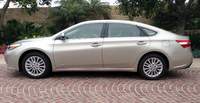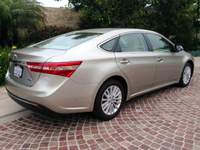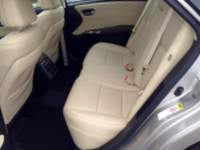Toyota’s Full-size Hybrid Sedan Leads in MPG
Toyota is the undisputed sales leader of hybrid technology vehicles, so it only makes sense they would put a hybrid in their full size car, the Avalon. What makes this competitively advantageous is that Toyota offers the only full-size non-luxury hybrid, resulting in the Avalon being the category’s fuel economy leader by a sizeable margin.

Toyota also makes the midsize sales leader in hybrid form, the Camry. So the question becomes: Is a bit more leg room worth the higher cost of the larger Toyota hybrid?
Drivetrain
The front-wheel drive Avalon Hybridis powered by Toyota’s Hybrid Synergy Drive system, which combines a 2.5-liter, 16-valve double overhead cam (DOHC) gasoline-powered, in-line 4-cylinder engine and a 105-kW electric motor with a nickel-metal hydride (NiMH) battery for energy storage. The two power sources produce a combined peak output of 200 hp and 156 lb-ft of torque through a very smooth electronic Continuous Variable Transmission, or CVT. This is the same drivetrain offered in the mid-size Toyota Camry Hybrid.
Fuel economy for the Avalon Hybrid is rated at 39 highway/40 city with a combined of 40 mpg. Running on regular unleaded, I drove 340 mostly highway miles and averaged 38.8 mpg but did not come close to using all 17 gallons in the tank. At my fuel consumption rate I could have traveled almost 660 miles.

To maximize fuel economy, Toyota’s Hybrid Synergy Drive automatically switches between the electric drive mode, combined electric and gasoline engine mode and only engine power. The transitions are seamless and smooth and can be monitored by viewing the dash gauges.
The Avalon Hybrid has three drive settings: Sport, EV and Eco, with Eco being the default setting for optimal fuel economy, and an auto-stop feature that temporarily turns off the gasoline engine (and puts the car into EV mode) to save fuel when coming to a halt. Taking your foot off the brake pedal automatically and seamlessly restarts the engine.
The NiMH battery is charged by the engine and through the regenerative charging system, which converts kinetic energy into electric energy and stores it in the battery when applying the brakes or coasting. This process also can be viewed on a dash gauge where you can watch the power flow into and out of the battery and engine.
Driving Experience: On The Road
The Avalon Hybrid weighs in at 3,585 lbs., which is only 124 lbs. more than the gasoline-powered, base model Avalon XLE. This is a small weight difference considering the added hybrid components.
As mentioned, the Avalon Hybrid has three drive modes going through the CVT. For best fuel economy the Eco mode reduces horsepower slightly but, when needed, is easily over-ridden to accelerate to change lanes or pass cars and trucks. The EV mode is for short distances and slow speeds and is most noticeable when in parking lots or pulling away from your home, office or a stoplight.
The most responsive drive mode is Sport, where the CVT is held in a RPM range longer than in Eco. I was impressed with the consistency of how the CVT and the engine’s computer management system are so well programmed and work together. Tromp on the accelerator and whoosh…off you go to 80 in a couple of seconds.
For those of you that have never driven a CVT, you should give it a try. I like them for their smooth operation, never feeling a gear shift, and fuel economy. As auto manufacturers constantly search for ways to increase fuel economy, more will be introducing the CVT into their vehicles.
The Avalon Hybrid XLE Premium comes with 17-inch alloy wheels and all-season tires, electrically power-assisted rack-and-pinion steering, front independent suspension with MacPherson struts and stabilizer bar, and dual-link independent rear MacPherson struts with a stabilizer bar. All this delivers a smooth and quiet highway ride with little wind noise. The Avalon Hybrid is not designed to be a sports sedan and wouldn’t necessarily be considered fun to drive, but unexpected freeway maneuvers and tight cornering were done with confidence. For a full-size sedan the Avalon Hybrid delivers a very nice, comfortable ride.
In my unscientific testing, the Avalon Hybrid ran just under nine seconds from 0 – 60, which is respectable for a full-size sedan. Another test revealed only about one second faster acceleration in Sport versus Eco, so off-the-line isn’t where the hybrid and CVT combination shine. Where you will notice it, as previously noted, is at freeway speeds where a CVT gets that done quickly and smoothly, finding the right powerband without ever feeling a gear shift.
But going fast is worthless if you can’t stop. The Avalon Hybrid comes with Toyota’s Electronically Controlled Brake system (ECB), which includes power-assisted disc brakes with ABS, part of Toyota’s Integrated Regenerative Braking system. The stops were straight and consistent, but at low speeds the brakes were, at times, a bit touchy, which the dealer service department may be able to dial out. Also, when coming to a stop, the combination of the regenerative braking and the hybrid motor made a noticeable whine.
Driving Experience: Interior
Clean Fleet Report was driving the base model, but nicely appointed, Avalon Hybrid XLE Premium. There are two higher optioned (and priced) versions: XLE Touring and Limited. The XLE Premium package included ivory-colored, power-adjustable, leather-trimmed eight-way heated driver (with power lumbar) and four-way heated passenger seats. After a bit of time playing with the power adjustments, a comfortable seating position was found, which included raising the seat that resulted in excellent sight lines. Features also include what are now considered to be standard equipment on many cars–power windows and door locks, 12V power outlets, auto-dimming rearview mirror, Homelink, cruise control, heated outside power mirrors, smart key system for the doors and trunk, push button start and illuminated entry.

The rear seats can hold three adults but two is more comfortable and convenient, as the center armrest folds down to reveal two cup holders. The rear seats do not fold flat as behind the rear seatback is the Li-ion battery. The trunk holds a respectable amount of luggage, but nothing longer than about three feet in length.
The cockpit design is driver-friendly with the gauges in easy sight and controls within easy reach, including many on the leather-wrapped steering wheel and the audio and navigation found centered in the center stack. The tri-toned front seating area included ivory on the seats, dash and door panels, a dark brown center armrest and cup holder area finished by black around the radio and instrument panel. Tasteful smoked chrome accents highlighted the center stack audio unit and was capped-off by a small, but prominent, area of high gloss wood-grain style trim above the glovebox. This all sounds like it could be busy, but the colors and materials work well together and compliment each other nicely. The Avalon easily is the most luxurious Toyota sedan, which is exactly where it is positioned in their lineup.

The Avalon Hybrid XLE Premium had Toyota’s Display Audio system, which included a nice base level of entertainment technology. Even though this Avalon is the base model in Toyota’s Avalon line, I was a bit surprised it did not have a higher level of standard equipment. The base Display Audio system includes a 6.1-inch touch-screen with AM/FM/CD player with MP3/WMA playback capability with eight speakers. There is an auxiliary audio jack, USB port with iPod connectivity, music streaming via Bluetooth wireless technology and hands-free phone capability. However, SiriusXM is not included, which was confusing as even most cars we test at a much lower price always have satellite radio. This is an odd feature to leave out of Toyota’s topline car, even if it is the base model.
A note about the 6.1-inch touch-screen. Its raked angle produces a glare, whether it is from the open sunroof or by light streaming through the windows, making it difficult, at the least, to all the way impossible to read at times. Most of the touch-screens we see are not laid back at such an angle or have a hood over them, shielding the sunlight.
But what is all the comfort and convenience worth if the car isn’t safe? The Avalon Hybrid is well-equipped with active and passive safety features including 10 air bags, TPMS (Tire Pressure Monitoring System), halogen headlights, integrated back-up camera, anti-theft alarm, collision sensors that deactivate the high-voltage battery, an energy-absorbing collapsible steering column and the previously mentioned four-wheel disc brakes with ABS, stability assist with traction control and electronic brake distribution.
Pricing
The 2014 Avalon Hybrid XLE Premium Clean Fleet Report was driving had a price of $36,615, including the $810 Delivery Processing and Handling Fee, which other car manufacturers call the Destination Charge.
The 2014 Avalon Hybrid comes in three models, but can be ordered with Option Packages that will affect your final price. The base MSRP for the three models, including the $810 Delivery Processing and Handling Fee:
- XLE Premium $36,615
- XLE Touring $37,810
- Limited $42,460
The 2014 Toyota Avalon comes with these warranties:
• 3 year/36,000 mile – Basic
• 2 year/25,000 mile – Free Maintenance and Roadside Assistance
• 5 year/60,000 mile – Drivetrain
• 15 year/150,000 – Hybrid-related Component Coverage for: California, Connecticut, Delaware, Maine, Maryland, Massachusetts, New Jersey, New York, Rhode Island and Vermont
• 8 year/100,000 mile – Hybrid-related Component Coverage for all states not listed above
• 5 year/Unlimited miles – Rust-through (corrosion perforation of sheet metal)
Observations: 2014 Avalon Hybrid XLE Premium
The Avalon was completely redesigned in 2013, which carries over to the 2014 model. And, what a redesign it was! The Avalon went from a boxy, completely forgettable car to a striking, cutting-edge look with a swept, coupe roofline similar to the Volkswagen CC, Mercedes-Benz CLA and Audi A7. The Avalon redesign of the interior has a luxury look and feel with refined materials, lighting and hand-stitched leather seats that add the touch of fine craftsmanship.
So, let’s go back to the question proffered in the opening: why, but for a bit more leg room would you consider a full size Toyota

Avalon Hybrid over the best-selling midsize Toyota Camry Hybrid, especially since the price difference can be as much as $13,000 more?
The answer is simple: a high level of luxury, modern style and interior fit-and-finish at the cost of a non-luxury class vehicle.
Designed in California and built in Kentucky, the 2014 Avalon Hybrid XLE Premium is a near-luxury car bumping real close to the luxury car category. It comfortably seats up to five adults, has a combined city and highway fuel economy of 40 miles per gallon and gets you to where you want to be in comfort and style with a high level of safety and reliability.
Luxury hybrids that would be a step up in style and features but cost tens of thousands more than the Avalon Hybrid are the Toyota-brand Lexus GS450h and LS600h, the Acura RLX and BMW 7 Series. None of these come close to the Avalon’s fuel economy; for that you’d need to look at a different approach, Audi’s A8 TDI diesel, or the ultimate, the pure electric Tesla Model S.
It all comes down to what makes you feel good, fits your lifestyle and gets you in the mood to tackle city streets and rush-hour traffic jams, then hit the open road for that long awaited and deserved vacation, saving money with each mile. The 2014 Avalon Hybrid will sooth those mood-challengers and swift you away to that vacation.
Whatever you end up buying, enjoy your new car and as always, Happy Driving!
Story and Photos by John Faulkner
Related stories you might want to check out:
Road Test: Chevy Impala LT
Battle of the Esses: S-Class Mercedes vs. Tesla Model S
Test Drive: Infiniti M35h Hybrid
Bbaby Brother Road Test: Toyota Camry Hybrid

0 thoughts on “Road Test: 2014 Toyota Avalon Hybrid XLE Premium”